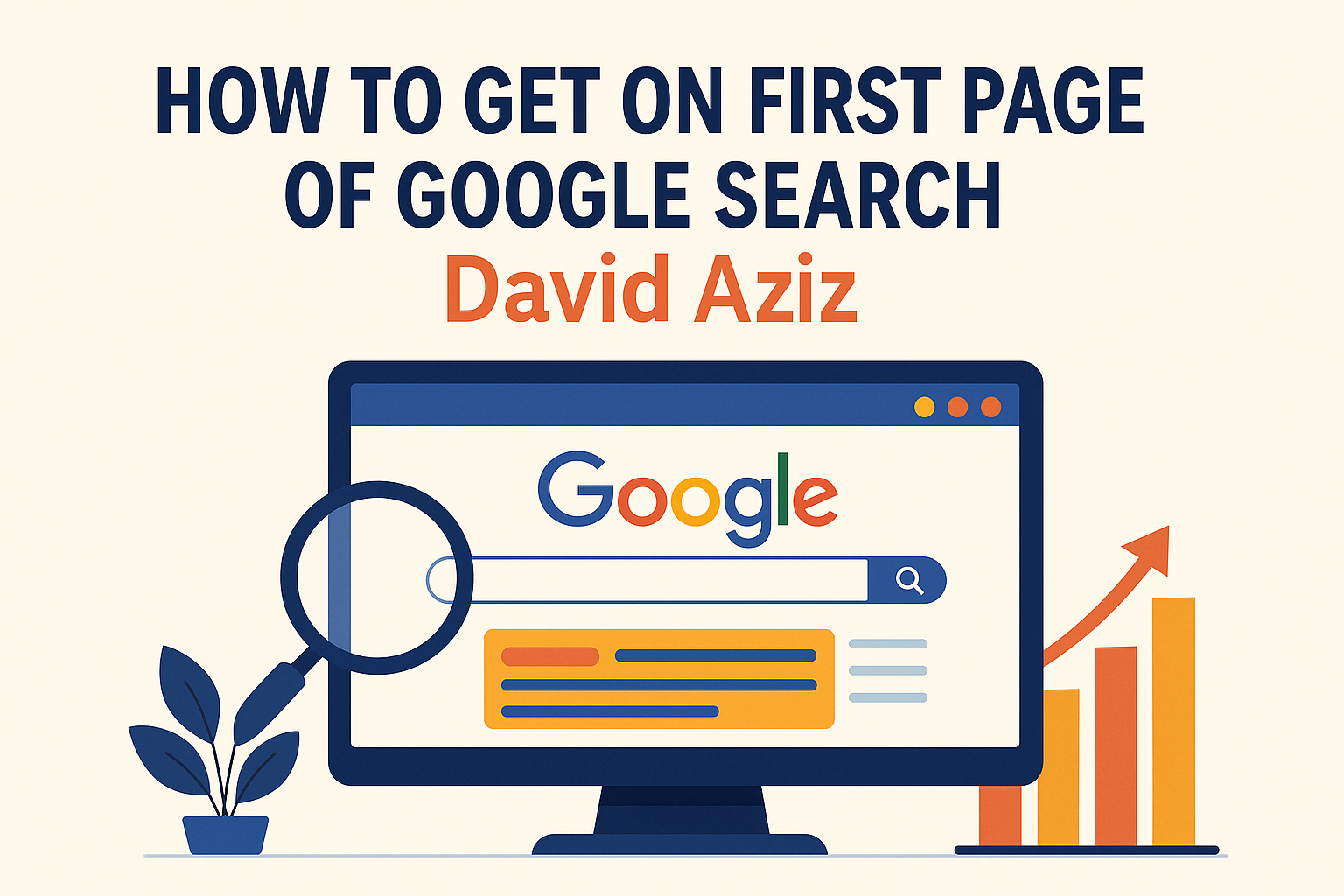How to Get on First Page of Google Search David Aziz

Achieving a position on the first page of Google search results is a coveted goal for any website owner or content creator. The reason is simple: most users don’t go beyond the first page when searching for information, products, or services. If your website or content is buried deep in the search results, it’s less likely to be seen by your target audience. In this comprehensive guide, “How to Get on First Page of Google Search David Aziz,” we’ll dive deep into effective techniques, strategies, and insights to help you improve your rankings and get your content on Google’s first page.
Understanding Google’s Ranking Algorithm
Before jumping into specific strategies, it’s essential to have a clear understanding of how Google ranks pages. Google’s search engine algorithm is sophisticated and constantly evolving, with hundreds of ranking factors considered. While the exact algorithm remains a mystery, some key factors have remained consistent over time and are critical for ranking higher in search results. These include:
-
Relevance: Google prioritizes content that matches the search intent. This means your content should thoroughly answer the user’s query and address their needs.
-
Content quality: The more valuable and informative your content, the more likely it is to be ranked higher.
-
Backlinks: Links from other high-quality, authoritative websites tell Google that your content is credible and trustworthy.
-
User Experience: If your website is slow to load, hard to navigate, or doesn’t function well on mobile devices, Google will likely rank it lower.
-
Page Speed: Websites that load quickly tend to rank better because users prefer sites that don’t keep them waiting.
-
Mobile Optimization: Google now uses mobile-first indexing, meaning it predominantly looks at the mobile version of a site to determine rankings.
With these factors in mind, let’s explore actionable steps to help you rank on the first page of Google search results.
Comprehensive Keyword Research
Effective SEO begins with understanding the keywords that your audience is searching for. In the case of “How to Get on First Page of Google Search David Aziz,” choosing the right long-tail keyword is crucial for targeting users who are specifically looking for this information. Long-tail keywords are phrases that are more specific and often less competitive, which makes them easier to rank for.
Using Keyword Tools
There are several tools available to help you discover the best keywords for your content. Some of the most popular tools include:
-
Google Keyword Planner: A free tool that helps you find keywords with good search volume.
-
Ahrefs: A premium tool that provides in-depth keyword analysis and competitor research.
-
SEMrush: Another paid tool that can help identify keywords and analyze competitors’ strategies.
-
Moz: Offers keyword suggestions, search volume data, and competition metrics.
When selecting a keyword, make sure it’s relevant to your content and aligns with the search intent. Also, aim for keywords that strike a balance between search volume and competition. Highly competitive keywords are more difficult to rank for, while keywords with low search volume may not bring enough traffic.
Keyword Placement
Once you’ve identified your primary keyword, strategically place it throughout your content. This includes the title tag, meta description, headers, and within the body of the text. However, avoid keyword stuffing. Google’s algorithm can detect overuse of keywords and may penalize your site for it. Use variations and related terms to make the content more natural and engaging.
On-Page SEO: Optimizing Your Content
On-page SEO refers to the actions you can take on your website to improve its ranking. This includes everything from the structure of your content to the images you use. Here are some key on-page SEO strategies to consider:
1. Optimizing Title Tags and Meta Descriptions
The title tag is one of the most important ranking factors. It is what appears in search engine results as the clickable headline. Include your target keyword near the beginning of the title and keep it under 60 characters to ensure it displays correctly in search results.
Similarly, your meta description, while not a direct ranking factor, should include the keyword and be compelling enough to encourage users to click. Keep it under 160 characters, and ensure it summarizes the content of your page effectively.
2. Content Quality and Length
Google values high-quality, in-depth content that provides real value to the user. To improve your chances of ranking higher, your content should be comprehensive and answer the searcher’s query in a thorough, well-organized manner. Aim for a word count of at least 1000-1500 words. However, length should never come at the cost of quality.
Ensure your content is original, well-researched, and free of errors. Break up large blocks of text with subheadings (H2, H3) to make the content easy to read and digest.
3. Use of Header Tags
Using proper header tags (H1, H2, H3, etc.) helps Google understand the structure of your content and makes it easier for readers to navigate. Make sure your primary keyword appears in the H1 tag (usually the page title), and consider using related keywords in H2 and H3 tags.
4. Internal and External Linking
Linking to other pages on your website (internal links) helps distribute link equity throughout your site and makes it easier for Google’s crawler to index your content. Additionally, linking to high-authority external websites adds credibility to your content. Be strategic and ensure that links are relevant to the context of your page.
5. Optimizing Images and Media
Images are a great way to make your content more engaging, but they also need to be optimized for SEO. Compress images to reduce file sizes and improve page load speed. Use descriptive, keyword-rich alt tags to help Google understand the content of the image. Additionally, videos and other multimedia elements can enhance the user experience and keep visitors engaged on your site for longer periods.
Off-Page SEO: Building Authority
While on-page SEO is essential, off-page SEO also plays a crucial role in determining how well your site ranks. Off-page SEO involves actions taken outside of your website to improve its authority, credibility, and trustworthiness in the eyes of Google.
1. Backlink Building
Backlinks, or inbound links from other websites, are one of the most significant factors for ranking higher on Google. They serve as a vote of confidence for your content. The more high-quality, relevant backlinks you have, the more authoritative your website will appear.
Focus on acquiring backlinks from authoritative sites within your industry. Some effective methods for building backlinks include:
-
Guest posting on reputable blogs.
-
Creating shareable content like infographics or in-depth guides.
-
Reaching out to influencers or bloggers for collaboration.
-
Using broken link building techniques to replace broken links on other websites with links to your content.
2. Social Media and Social Signals
While social media doesn’t directly affect rankings, promoting your content on social platforms can increase its visibility and drive traffic to your website. The more engagement your content receives, the more likely it is that people will link to it, further boosting your rankings.
Mobile Optimization and User Experience
Google now uses mobile-first indexing, which means that the mobile version of your website is the primary version that is used to rank your site. If your website is not optimized for mobile devices, you could be missing out on a significant amount of traffic.
Ensure that your website is responsive, meaning it adapts to different screen sizes and devices. Additionally, focus on improving the user experience (UX) by making your website easy to navigate, fast to load, and free of errors.
Technical SEO: Site Speed and Crawlability
Technical SEO refers to the backend elements that help search engines crawl and index your website. Here are a few key aspects to consider:
1. Improve Site Speed
Site speed is a ranking factor, and slower websites tend to have higher bounce rates, which can hurt your rankings. Use tools like Google PageSpeed Insights to test your site’s speed and implement recommendations to make your site load faster.
2. Fix Crawl Errors
Googlebot, the search engine’s crawler, needs to be able to access and index your content. Use Google Search Console to monitor crawl errors and fix any issues that could prevent Google from indexing your site properly.
Consistency and Patience: The Long-Term SEO Game
Achieving a top spot on the first page of Google doesn’t happen overnight. SEO is a long-term strategy that requires consistency and patience. Regularly update your content, track your rankings, and adjust your strategy as needed.
Read also: The Road to Financial Freedom: Unveiling the Secrets of Make1m.com Millionaire Life
Conclusion
Getting to the first page of Google search results is not an easy feat, but with the right strategies, it is absolutely achievable. By focusing on keyword research, on-page optimization, high-quality content creation, and building backlinks, you can significantly improve your chances of ranking higher on Google. Remember, SEO is a marathon, not a sprint. Stay consistent with your efforts, track your progress, and refine your strategies as necessary to continue improving your rankings over time.
By following the steps outlined in this guide on “How to Get on First Page of Google Search David Aziz,” you’ll be well on your way to achieving better visibility, more traffic, and ultimately, greater success in the digital space.



